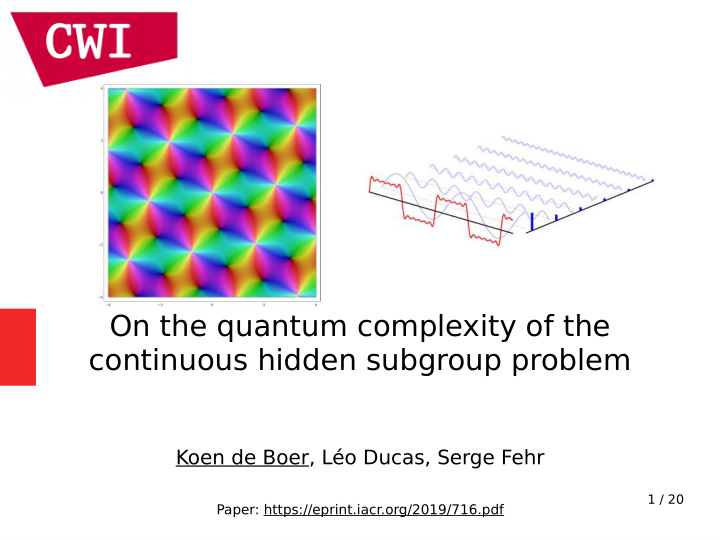



On the quantum complexity of the continuous hidden subgroup problem Koen de Boer, Léo Ducas, Serge Fehr 1 / 20 Paper: https://eprint.iacr.org/2019/716.pdf
Overview ● Introduction ● Problem statement ● Quantum algorithm ● Error analysis 2 / 20
Introduction (2014) ● Generalizes the Hidden Subgroup Problem to ● Computes unit groups of number fjelds ● Used to prove a (quantum) hardness-gap between Ideal-SVP and SVP [CGS14,CDPR16,BS16] ● Possible conseq. in crypto based on lattices with 3 / 20 algebraic structure [CDW17]
Introduction Shortcomings Extended abstract (2014) ● No exclusion of intractable instances ● Polynomial in which variable? ● Only high-level reasoning in the ext. abstract ● Up to now, 5 years later, no full version published 4 / 20
Problem statement (informal) ● Given a ‘nice’ periodic function, fjnd its period. Period ● More psychedelic example in 2d: ● Insight: In higher dimensions the period is 5 / 20 encoded by a lattice
Problem statement (formal) ● Given black-box access to a function that satisfjes the following: (i) is periodic w.r.t. some lattice (ii) is Lipschitz-continuous (iii) is seperable , i.e., not too constant. ● Find: A -approximate basis of the lattice 6 / 20
Our contributions ● Statement with all dependencies on parameters ● Rigorous proof of this statement ● Simplifying the quantum algorithm of Eisenträger et al. 7 / 20
High level approach This talk ● Sample approx. dual lattice points using a quantum algorithm ● From enough of such , recover an approx. dual basis ● From recover an approx. primal basis 8 / 20
Some important thoughts ● The notion of the dual lattice ● Defjne ● Every nice -periodic function can be written with the Fourier decomposition of 9 / 20
One more important thought ● The convolution theorem 10 / 20
Global idea ● Create the Gaussian superposition ● Query in superposition ● Apply the Fourier Transform ● Measure 11 / 20
Global idea ● Create the Gaussian superposition ● Q computers only have finitely many qubits ● Query in superposition ● We need to discretize and ‘window’ the wave ● Fourier transf. becomes Finite Fourier Transf. ● Apply the Fourier Transform ● Measure 12 / 20
Quantum algorithm Actual case: Ideal case: Finite Fourier Fourier transform transform ? restricted to grid 13 / 20
Quantum algorithm ● How ‘fine’ must the grid be? ● How is it related with parameters a, r, ε, τ ? ● How fast is the convergence? Actual case: Ideal case: Finite Fourier Fourier transform transform ? restricted to grid 14 / 20
Fourier transforms 15 / 20
Fourier transforms ● These are pointwise errors ● We want the error in the L 2 - distance We want the sum of those to be small 16 / 20
Actual Analysis ● Grid → Unit cube: the Yudin-Jackson theorem About optimal trigonometric approximations ● Unit cube → real space: the Poisson Summation Formula About the interplay between Fourier transforms the operations ‘restriction’ and ‘periodization’ on functions 17 / 20
Main theorem we need This high complexity is mostly due to numerical instability of generating a dual 18 / 20 basis and inverting this basis to obtain a primal basis.
Open questions ● Complexity unit group or class group computation? ● Complexity of Principal Ideal Problem? ● Are there assumptions on the oracle function making the complexity better? ● Using BKZ to improve the numerical stability of recovering the primal basis? ● Using sublattices or symmetries of lattices to 19 / 20 improve complexity
Questions? 20 / 20
Recommend
More recommend